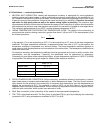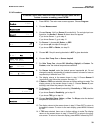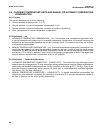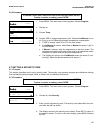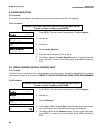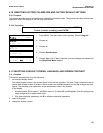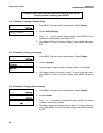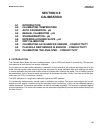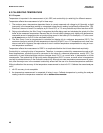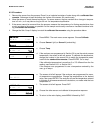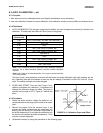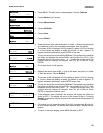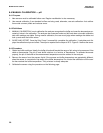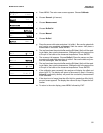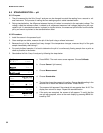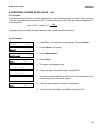
46
MODEL SOLU COMP II SECTION 6.0
CALIBRATION
6.2 CALIBRATING TEMPERATURE
6.2.1 Purpose
Temperature is important in the measurement of pH, ORP, and conductivity (or resistivity) for different reasons.
Temperature affects the measurement of pH in three ways.
1. The analyzer uses a temperature dependent factor to convert measured cell voltage to pH. Normally, a slight
inaccuracy in the temperature reading is unimportant unless the pH reading is significantly different from 7.00.
Even then, the error is small. For example, at pH 12 and 25°C, a 1°C error produces a pH error less than ±0.02.
2. During auto calibration, the Solu Comp II recognizes the buffer being used and calculates the actual pH of the
buffer at the measured temperature. Because the pH of most buffers changes only slightly with temperature,
reasonable errors in temperature do not produce large errors in the buffer pH. For example, a 1°C error caus-
es at most an error of ±0.03 in the calculated buffer pH.
3. The Solu Comp II can be programmed to calculate and display pH at a reference temperature (25°C). The
maximum change in solution pH with temperature is about ±0.04 pH/°C, so a 1°C temperature error does intro-
duce a small error. However, the major source of error in solution temperature compensation is using an incor-
rect temperature coefficient.
Temperature affects the measurement of ORP in a complicated fashion that is best determined empirically.
Conductivity is a strong function of temperature. Therefore, to compare conductivity measurements made at dif-
ferent temperatures, conductivity must be converted to the value at a reference temperature, usually 25°C. The
conductivity of most dilute electrolyte solutions changes about 2%/°C, so a small error in temperature is of little
consequence. The conductivity of high purity water changes about 5%/°C or more, so small errors in temperature
can lead to substantial errors in the corrected conductivity. Although accurate temperature measurement is impor-
tant, often the major error in the corrected conductivity arises from the use of an incorrect temperature coefficient.
Without calibration the accuracy of the temperature measurement is about ±0.4°C. Calibrate the sensor/analyzer
unit if
1. ±0.4°C accuracy is not acceptable
2. the temperature measurement is suspected of being in error. Calibrate temperature by making the analyzer
reading match the temperature measured with a standard thermometer.



